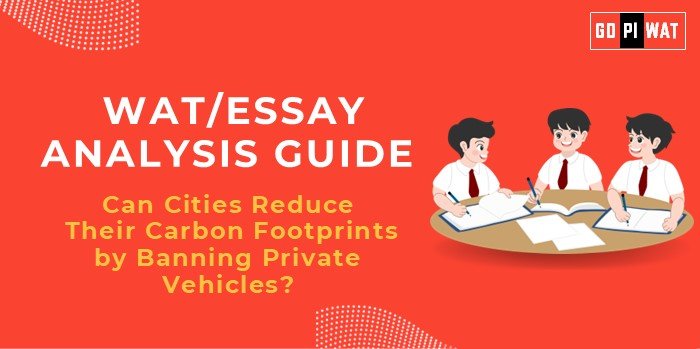📋 Written Ability Test (WAT) Analysis Guide
Can Cities Reduce Their Carbon Footprints by Banning Private Vehicles?
🌐 Understanding the Topic’s Importance
Transportation reform is pivotal in urban climate strategies. Writing on this topic demonstrates awareness of sustainability challenges and policy trade-offs, crucial for B-school discourse.
🕒 Effective Planning and Writing
- Time Allocation:
- Reading & Planning: 5 minutes.
- Writing: 20 minutes.
- Review: 5 minutes.
- Preparation Tips:
- Note examples like Oslo’s success or challenges faced by Beijing.
- Highlight stakeholders and data, such as urban emissions statistics.
✍️ Introduction Techniques
- Contrast Approach: “While urban transportation powers economies, it also drives 24% of global CO2 emissions. Could banning private cars transform cities into climate leaders?”
- Solution-Based Approach: “Urban transport reforms like banning private vehicles could pave the way for sustainable cities—if executed inclusively.”
- Historical Perspective: “From London’s congestion charge to Oslo’s car-free zones, cities have grappled with balancing mobility and sustainability.”
📖 Structuring the Essay Body
- Achievements: Highlight examples like reduced air pollution and improved health.
- Challenges with Comparative Analysis: Discuss economic disruptions and public resistance, referencing Beijing or Paris.
- Future Outlook: Suggest sustainable policies, emphasizing EV adoption and transit investments.
🎯 Concluding Effectively
- Balanced Approach: “Banning private vehicles can reduce carbon footprints if supported by equitable, efficient transit systems.”
- Global Comparison: “From Oslo to Bogotá, car bans have shown promise, but scaling them globally requires nuanced, inclusive strategies.”
🔍 Analyzing Successes and Shortcomings
- Key Achievements: Cleaner air, healthier cities, and climate leadership.
- Ongoing Challenges: Equity issues, infrastructure gaps, and resistance.
- Global Context: Oslo’s success, Beijing’s struggles.
📑 Recommendations for Sustainable Progress
- Enhance public transit to absorb demand.
- Promote electric and shared mobility.
- Ensure inclusivity through subsidies and community engagement.
✏️ Sample Short Essays
- Balanced Perspective: “Banning private vehicles offers an opportunity to reduce emissions, but its success hinges on robust public transit and inclusivity.”
- Solution-Oriented: “Sustainable urbanization demands bold measures, like banning cars, paired with equitable transit options.”
- Global Comparison: “Cities like Oslo demonstrate the potential of car bans, but the approach must adapt to local socioeconomic realities.”


